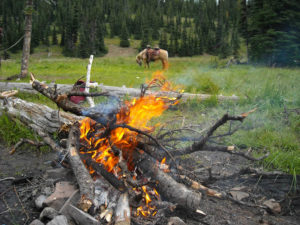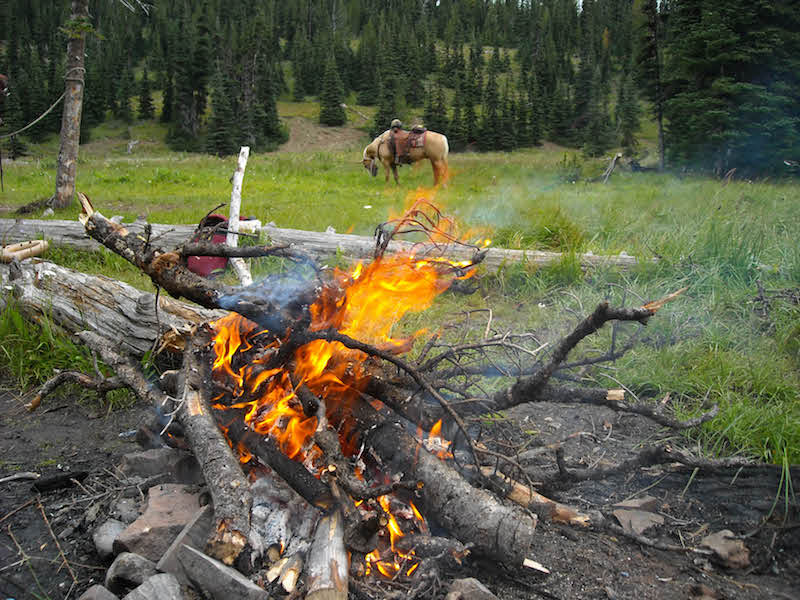The ABCs of Campfires, Camp Stoves and Dutch Oven Cooking
by Robert Eversole

An oft-quoted saying of Napoleon Bonaparte was that “An army marches on its stomach.” This bit of wisdom is also relevant to horse riders and campers. After all, a great camp dinner is a beautiful flourish to end a perfect day in the saddle. This month let’s talk about a few of the different ways to stay fed while camping with our mounts.
It’s no secret that I’ve enjoyed a long association with the Back Country Horsemen in various capacities. It may however be a surprise that my involvement grew not from the many trail advocacy efforts of the organization, but from the legendary Dutch oven cooking that often goes along with BCH events. Yes, The TrailMeister is a chow hound! The promise of a Dutch oven feast is often the easiest way to have me attend a ride or give a talk on land navigation and horse camping.
The Dutch oven—this thick-walled chunk of cast iron—has been around for hundreds of years and for good reason. They’re wonderful for wood fired cooking and can produce a meal fit for royalty. About the only downfall to a Dutch oven is its weight. At nearly 15 pounds for a smallish oven I don’t envy Lewis and Clark who hauled one across the continent during their Corps of Discovery Expedition. The weight is the biggest reason why you’ll most often find Dutch oven feasts at the trailhead and not so often in the backcountry. If we ever meet while I’m trailhead camping stop by for a bite; chances are I’ll have my Dutch oven on the fire and spaghetti will be on the menu.
While a Dutch oven is faultless for trailhead cooking, the small size and negligible weight of modern backpacking stoves make them perfect for backcountry trips. In my opinion, there aren’t many things better than a quiet breakfast while watching the animals graze in a remote meadow. A small backpacker’s stove is perfect for providing a cup of coffee and oatmeal for this type of repast. When I venture into the backcountry without pack stock, weight and volume are my prime considerations. To reduce the load as much as possible, I’ve found that a single burner stove works well for me. Feather-light and fitting in the palm of your hand, these stoves easily produce the piping hot water needed for coffee and dehydrating freeze dried fare.
You might wonder that if weight is such a concern why not just make a campfire and use that for cooking? I love a good campfire and whenever possible have one at my camp. Unfortunately, campfires aren’t always a viable option. Open fires are often illegal during the summer months when we’re in the backcountry and if fires are allowed there are no guarantees that dry wood can be found. For peace of mind and a full stomach, a camp stove of some type is often your best bet.An in between camp stove that works quite well when pack stock are in the picture is the classic, and “old reliable,” Coleman Camp Stove. These nearly indestructible work horses allow for multi-course dishes in the grandest restaurant of all: The Great Outdoors.
My first and most memorable backcountry trip was with two long time Backcountry Horsemen of Washington members who introduced me to the world of camping with pack animals. The meal that I made by adding hot water to a plastic bag of “stuff” was pleasant, but in no way compared to the grand meal of steak, zucchini, onions and green beans that were deftly prepared on a battered two burner stove pulled from the depths of a pack mule’s pannier bag. I’m eternally grateful not just that Russ and Ken shared their feast, but more so that they introduced me to the experience of enjoying the backcountry with horse and mule. I hope everyone who reads this has the good fortune to find mentors similar to these two wonderful gentlemen.
I hope that this month has opened up a few options for you in terms of eating well while camping with your livestock. As always, for more information about trail riding and North America’s largest directory of horse trails and camping areas in the U.S. visit www.TrailMeister.com.
Published May 2014 Issue

Robert Eversole, ”the trail meister,” owns www.TrailMeister.com, the largest database of horse riding and camping areas in the U.S. with free trail and trailhead information, trail maps, and much more to help horse enthusiasts experience the joys of trail riding. Robert is a registered riding instructor with PATH International, a mounted search and rescue team member, and a U.S. Marine who has served on the board of the Backcountry Horsemen of Washington (BCHW). He is enjoying his new career helping fellow trail riders stay found and safe on the trail. When not on the trail, The Trail Meister resides near Spokane, WA and teaches land navigation to a wide variety of outdoor groups across the nation. For North America’s largest horse trail and camping directory, trail tips, and more, visit www.TrailMeister.com.






